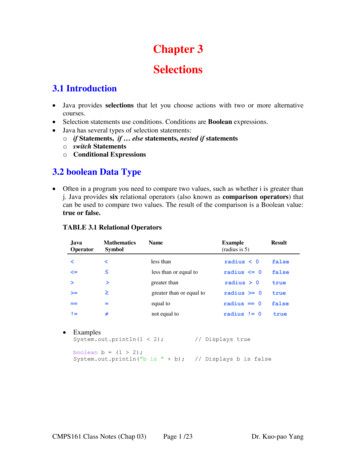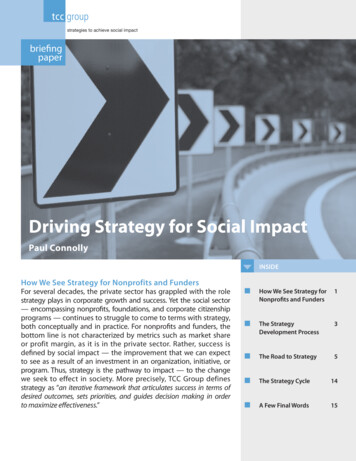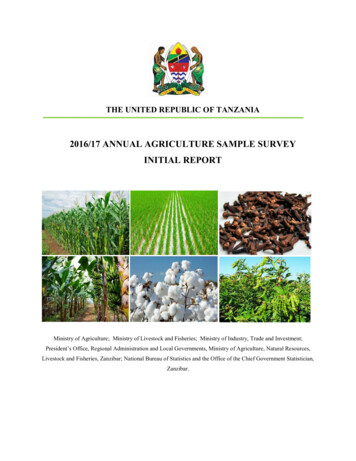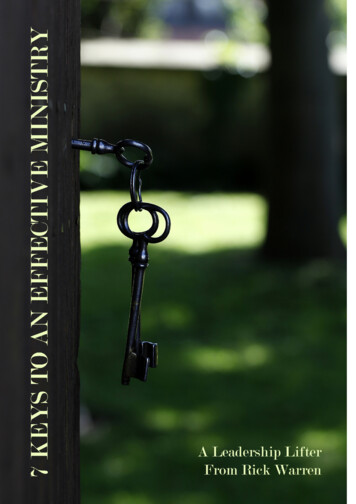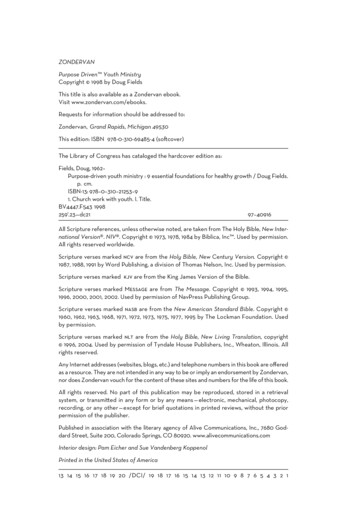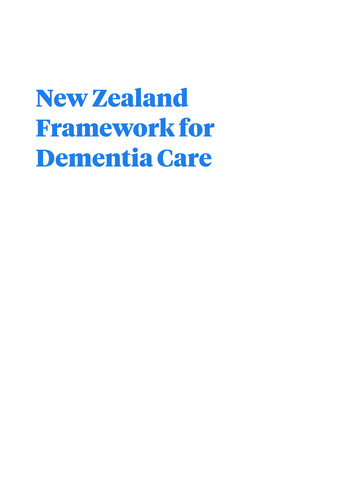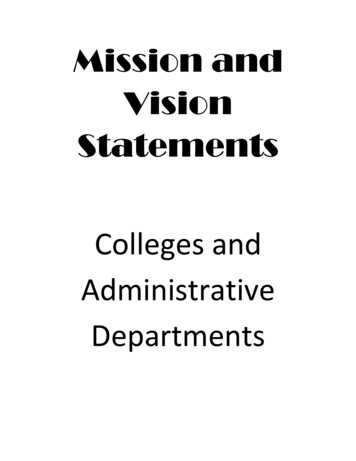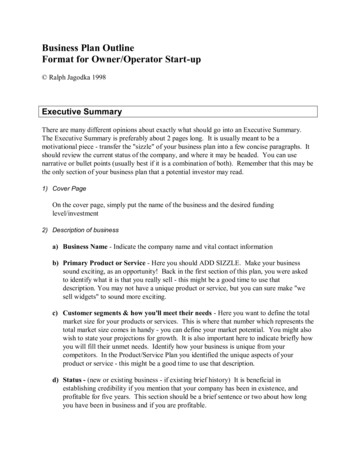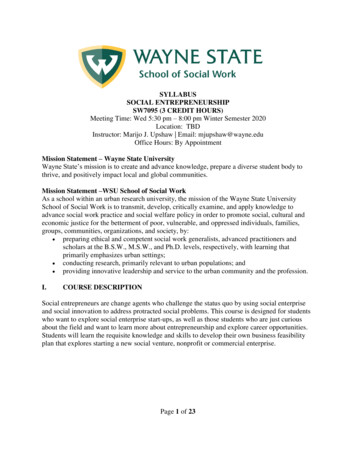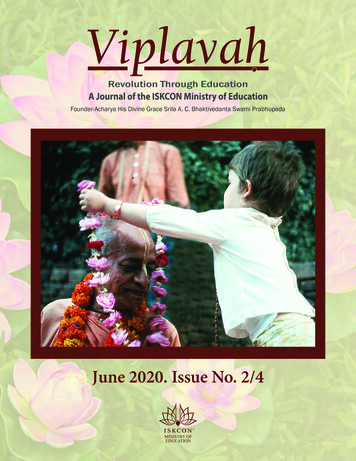
Transcription
MISSION STATEMENTVision statementTo provide Krishna conscious education of high quality to everyone through temples, educationalinstitutions and various global initiatives.Mission statementTo develop comprehensive educational systems globally, that foster higher spiritual values, fulfil theneeds of ISKCON members, and the larger society, bringing about excellence in all areas of humanlife. We aim to fulfil this mission by1. Empowering and supporting educational initiatives and collaborations among educators, educational institutions and professionals2. Establishing and monitoring high standards of Vaisnava education3. Supervising the development and execution of educational plans and ensuring they are delivered to high standards and4. Understanding and fulfilling the educational needs of the Krsna conscious families5. Making every temple as an educational centre and a centre of excellence.MASTHEADViplavah is a Journal of the Ministry of Education of the International Society for Krishna Consciousness, Founder Acharya His Divine Grace Srila A. C. Bhaktivedanta Swami Prabhupada.Minister of Education: H. G. Sesa DasExecutive Director: Tapana-misra DasCore Committee: Hanumatpresaka Swami, Sesa Das, Atul-krsna Das, Rama-giri-dhari Das, Tapan-misra Das, Champaka-lata Devi Dasi, Indira-sakhi Devi Dasi,Executive/Issue Editor: H. H. Hanumatpresaka SwamiEditorial Board: H. G. Indira-sakhi Devi Dasi H. G. Rama-giridhari DasThe first issue of the Journal was published Janmastami 2017, publishing four issues each year. It isdriven out of North American and the Western Hemisphere but is aimed at serving the educationalneeds of ISKCON globally.Ministry Web Site: iskconeducation.orgFor Correspondences: Secretary, viplavah.iskcon@gmail.com2
CONTENTSSrila Prabhupada Uvaca. 4Letters from the Editors. 4General Editor. 4Managing Editor. 5ISKCON Primary Schools and Their Philosophies. 6Holistic development through Panch Kosha Vikas (Bhaktivedanta Model School, Pune). 6Preaching through Teaching (Bhaktivedanta National School, Mayapur). 11The School Education – an Eternal Perective(Bhaktivedanta Gurukula and International School, Vrindavan). 13Educational Resources. 19The Importance of studying Srimad-bhagavatam with Our Children. 19Srimad-Bhagavatam for Children in the Mexico Yatra. 22Crossing over the Challenges in Sunday School Preaching. 23Preparing Devotee Educators for Online Learning & Teaching. 27From Daughters to Devotees: Homeschooling Girls. 31Srila Prabhupada’s Pandemic Prediction & Varnasrama College Online. 34Voice of the Youth. 36How I was Rescued by ISKCON Education. 36My Journey from ISKCON Student to ISKCON Teacher. 38Book Review. 41Srimad-Bhagavatam: A Comprehensive Guide for Young Readers by Aruddha Devi Dasi. 41Reports from Ministry of Education. 45International Education Symposium: Viplavah 2020. 452020 – Pan-American Sastra Sam-mela. 47Calendar. 48Next Issue. 483
Srila Prabhupada UvacaAny moment death can take place. Not that “I am now kumāra, I can play. When I shall becomeold man, I shall chant Hare Kṛṣṇa.” This is not a very good policy. Prahlāda Mahārāja says,“No. Immediately.” Kaumāra ācaret prājño dharmān bhāgavatān iha. Therefore the children, thosewho are actually dhīra, Vaiṣṇava, they should give education to the children. What education? Notthis so-called technical education or smoking education, drinking education and so many rascal education. This is not education. Education means bhāgavata education: to understand God. That iswanted. Athāto brahma jijñāsā. Education should be given in such a way that the student should bevery, very inquisitive. Inquisitive what about? Inquisitive about Brahman, not about this body. Thebody is matter, and the spirit soul is Brahman. Athāto brahma jijñāsā. This is human life. One shouldbe inquisitive to know about spiritual life, what is spirit soul. That is the first education. But where isthat education? There is no such education. Prahlāda Mahārāja teaches that immediately, from thebeginning of life, as soon as one is four or five years old, he should be educated about Brahman. Thatis called brahma-jijñāsā. Beginning. That is wanted.(Lecture on SB 1.7.18 -- Vrndavana, September 15, 1976)Letters from the EditorsGeneral EditorBy Hanumatpresaka SwamiProducing this Journal, Viplavah, is a herculean task. We thank everyone, especially Indira-sakhi Devi Dasi, the current Managing editor.The articles that follow are very weighty and the reader might feel that some editing might have beendone to avoid redundancy etc. but we think they will also appreciate that there is just not time for thisand that the reader has to do their work also, to get this essential work out.The tenor and individual character of the authors and articles will certainly be very quickly obviousto the discriminating reader, and they will certainly scan some of the articles and become absorbed inothers, agree, disagree and demand more details on others4
Managing EditorIndira-sakhi Devi DasiThe theme of this issue of Viplavah is ‘Raising Prahlad-like Children:Children’s Education in ISKCON.’ I am grateful to HH Hanumatpresaka Maharaja for giving me the opportunity to be the Managing Editor forthis issue, particularly because the theme is one that is very close to my heart.As a parent I have seen my girls blossom in the association of devotees whilestudying in an ISKCON school. Unfortunately, such schools are few and far between. I hope that asa society we take up developing children’s educational programs with the urgent priority that it deserves, so that more and more devotee children get a chance to be well-versed with Krsna consciousphilosophy from a very young age, as recommended by Prahlad Maharaja and Srila Prabhupada.We have articles from three leading schools in ISKCON. The educators emphasize that impartingVedic knowledge alongside the modern curriculum helps bridge the gaps in a system that is centeredsolely on the material dimension and provides a more balanced, holistic education. Such schools arenot for devotee children alone. In fact, in one sense they are powerful preaching centers.Apart from formal education in schools, another aspect of children’s spiritual education that we arefocusing on in this issue is exposing the children to the sublime philosophy of Srimad-bhagavatam.Apparently it’s never too early, as Aruddha Mataji mentions in her article: “In London, some parentshave formed a ‘Baby Bhagavatam’ group where they teach Srimad Bhagavatam to children aged 3-6 infun and engaging ways.” It is wonderful to see the positive effect that Srimad-bhagavatam is having oninnumerable children around the world on a day-to-day basis. Fittingly, our ‘Book Review’ sectionevaluates Aruddha Mataji’s multi-volume Srimad-Bhagavatam study guide for children which is beingused in many ISKCON schools and Sunday Schools.We also have articles discussing Sunday School challenges, homeschooling strategies and online education for children. Virtual education is specially relevant in the current world health crisis that ispreventing traditional face-to-face interaction between educators and students. In this context we arealso happy to announce the ministry’s collaboration with Varnasrama College Online. Included inthis issue is a report on the Ministry of Education’s annual international educational symposiumthat was held in Sri Dham Mayapur in February 2020.It is said that the youth is the future. We are pleased to introduce ‘The Voice of the Youth’ in this issue,a section focusing on the realizations of the next generation devotees in ISKCON - their hopes andaspirations, their expectations and disappointments, and their determination to continue the missionof our beloved founder acarya. In this issue two dynamic young devotees share their experience ofundergoing education in ISKCON.I am grateful to all the devotees who have worked behind the scenes to produce this issue. I am thankful to Chetan Hazare Prabhu for his suggestions regarding the structure and content of the journal.Thank you to Caitanya Prasad Prabhu for helping in so many ways from proofreading to sourcingphotographs, and in general for being enthusiastic to serve.We hope that this issue is useful and inspiring for devotees engaged in pushing on Srila Prabhupada’srevolution through education. Hare Krsna5
ISKCON Primary Schools and Their PhilosophiesHolistic development through Panch Kosha Vikas(Bhaktivedanta Model School, Pune)By Tulsi DasAbout usThe Bhaktivedanta Model School was an initiative started in 2011 byparents seeking a more wholesome, holistic approach to their child’seducation. Many of the teachers, including our Director who heads themanagement committee, are parents of children currently enrolled in our school. This helps our educators develop a more personal bond with each student, making every classroom a home where ourchildren are comfortable to learn and grow.The school currently has a roll of 190 students, with a staff of 24 teachers dedicated to giving our students the best of both worlds. Srila Prabhupada easily blended eastern wisdom with western technology. We teach modern academics steeped in Vedic culture. Our vision is “To nurture future generationsby sowing seeds of greatness within the soil that is Vedic culture while remaining relevant to the worldaround us.” We do this by incorporating the “Pancha Kosha Vikas” which fully satisfy the holisticdevelopment of our students. This is taught alongside a CBSE (India’s Central Board of SecondaryEducation) curriculum, enriched with additional Vedic subjects to make it “CBSE ”. In an effort tomake these methods even more academically sound, the school is in the process of developing its ownbooks for various levels to achieve our vision.6
Bhaktivedanta Model School’s daily schedule is filled with Vedic/cultural activities with the goal ofbringing our students closer to the lotus feet of Lord Sri Krishna. Sastra classes, daily aratis, BG slokarecitation, Ramayan reading, SB discussions, and ecstatic festival celebrations are just some of the activities we engage our students in to keep their minds Krishna conscious at all times.A focus on the Vedic perspective is the methodology we adhere to when teaching any academic subjects. Be it Science, Math or Social Sciences students are given both a Vedic and modern perspective,in this way we balance both the spiritual and mundane most effectively.Our PhilosophyA good education should cater to the all-round development of a child, from body, mind to soul.When the development is organic and gradual, it brings out the true nature of a child, and remainswith them throughout their growth. Vedic literatures, especially the Taitariya Upanishad, thereforetalk about the development of the 5 layers of every child. These 5 layers are called “Panch KoshaVikas.” The Bhaktivedanta Model School places a heavy emphasis on these teachings, incorporatingit into every phase of our children’s learning and development process. A quick overview of these 5important koshas is given below.Annamaya Kosha:Ayurveda describes this body in great detail as made up of the seven dhatus, three doshas and threemalas. The principle of utility and ability of the body depends upon how well it is developed. A weakand underdeveloped body will not be able toperform any of its assigned duties – materialor spiritual. For this, yukta ahar and vihar areprescribed: yogasanas and exercise, proper diet,sleep, etc. Any offsets at this level will requirecorrection.This kosha spans the age group of 0-9 years.(The age limits are indicators with a margin of2-3 years) As per medical science, the brain andlungs develop fully by the age of 7 and the heartat 9. So giving proper nourishment and exercisein early years of schooling is of utmost importance, much more so than the 3 Rs of education.Neglecting this has resulted in problems likeearly onset of physical ailments, mental diseases, and an overall degenerated lifestyle. Why?Because the education system that has createdtoday’s youth did not pay enough attention todiet and exercise during annamaya kosha. Achild needs extensive physical workouts to develop his lungs, increase circulation and developflexibility. But imagine a child who only sits withbooks, or worse, an electronic device, for hours daily from age 4 to 8, how would his body cope upwith the strains of later life? It is no wonder then that these organs fail in their 30s, 40s or 50s. Consider7
the example of a butterfly - if someone takespity on the struggling creature and assistsit in breaking free of the chrysalis, then thegrowth of that butterfly remains stunted forlife. But when the struggle is its own, onlythen will a fully-developed, healthy butterfly emerge. Same is the case with children.The body is our vehicle to success, so weneed to develop and take care of it. The onewho exemplifies that I am not this body, butthe body is mine to work with, has experienced a fully developed annamaya kosha.Pranamaya Kosha:This kosha is subtler than, and works independently of, the annamaya kosha. It is because of the pranamaya kosha, or the living force, that the body gets the ability to work. Respiration, secretion andcirculation of fluids, digestion, sensory perception, speech and excretion are the major functions ofthis kosha, which are carried out by the different vital airs in our body as Srila Prabhupada mentionsin BG 4.27.This kosha roughly covers the age group of 7-12 years. It is due to the pranamaya kosha that one’sphysical stamina develops, and continuous regeneration of the body takes place. The body remainsfunctional, capable of interacting with the environment as well as living entities around it. The symptoms of life are rooted here. Being subtler than the gross body, this kosha maintains control over it,and hence plays a vital role in human development. It also plays an important part in the developmentof the other koshas, for example, development of the udana vayu ensures proper functioning of theintellect, skills, etc.8
Manomaya Kosha:The five senses and their controller – the mind – constitute this kosha. These elements help us interact with the outside world. We experience the dualities of like/dislike, attachment/revulsion, etc. Theidea of the universe, the identity of the self and its relationship with the Creator and His creation, ourthoughts and emotions, etc. have their roots in this kosha. Ignorance, knowledge and the cognitivemind are its different aspects.The age group for this kosha is 9-14 years. This kosha isextremely important, for it is in the mind that the valuesystem of a child develops. Having strong bodies andvitality, but using it for adharmik goals would be akin tocreating Duryodhanas. Inspirations, idealism and rolemodels take birth in this kosha. Hence, imbibing storiesof great heroes from the shastras, demonstrating clearlythe dualities of life is of tremendous benefit at this stage.Let the children be inquisitive - a knowledgeable facilitator, who also emulates good behaviour, can lay a solidfoundation and spark dreams in these little minds.Efforts should be taken to reduce the influence of rajas and tamas and increase sattva guna to developthis kosha. The difference between permanence and impermanence should be made clear. Attachmentto sense objects, as well as those under the control of their senses, will weaken the mind. An impuremind leads one to the path of ignorance and ultimate destruction. Purification and development ofthis kosha to its utmost capacity proves to be a major milestone in transforming man into an efficient,righteous being.Vijnanamaya Kosha:This kosha sees its onset at the age of about 14.The intelligence constitutes the vijnanamayakosha. A child’s power of discrimination develops due to his intelligence. Intelligence creates areflection of the world and makes it relatable tous. We can explore the world around us throughimagination, conceptualization, memory andunderstanding, which are honed by the intellect.Analyzing and synthesizing are two important activities to be performed in this age group.Observing the diverse aspects of life, and yetacknowledging their integration is essential.Children of this age are naturally curious. Theyshould be encouraged to ask ‘why’ and ‘how’about everything, and stimulated to think and respond differently to various narratives they comeacross. The nature of the soul can be established as a result of such inquiry. This acts as the steppingstone to the next and final level - the anandamaya kosha – the ultimate aim of human life.9
Anandamaya Kosha:The joy derived from our divine connection are rooted in the anandamaya kosha. This kosha coversall the states of consciousness – waking, dreaming, deep sleep and samadhi. Far-sightedness and theexperience of extreme agony and bliss are the different aspects of it. In the perfected stage it would encompass eight symptomsof ecstasy. ISKCON aimsat mainly deals with thiskosha.This kosha helps in the development of compassionand love for all living entities. The sat, cit and ananda nature of the soul canbe understood at this level,and hence our relationshipwith God can be established. It is at this stage thatimparting devotional practices such as chanting, meditation, deity worship etc will be of maximumbenefit. The success of this kosha is the fructification of our bhakti at the prema stage – the ultimate,love of God.Conclusion:Once the anandamaya kosha sets in, the strengths and limitations of every individual can be assessed.One can know one’s own mindset, identifying his role in society, thus paving the way to self-realisation. Exceptional ones like Prahlad Maharaj will anyway take to the highest kosha from early childhood and perfect himself. But one who is unable to attain the highest goal can still follow the path ofdharma, be principle-centered in whatever he does and contribute for the betterment of society. Hedoes not become a sinful enjoyer of the senses and remains a big asset to the Krishna consciousnessmovement. The 3 purusharthas of dharma, artha and kama can be worked on at appropriate levelsso that moksha and bhakti can be easily achieved. And this is how the holistic education of a child iscomplete.The Vedic body of knowledge helps us with this. We thus need to pay more attention to integrate thisconcept into our current education systems by which an ordinary child also attains success in this lifeand the next, which is the sole purpose of the Panchakosha methodology.About author:Tulsi das aka Tushar Gaikwad is a mechanical engineer by profession working in a Tata group of companies as Sr. Project Manager and also handling responsibility as the Director of the BhaktivedantaModel School, Pune10
Preaching through Teaching(Bhaktivedanta National School, Mayapur)By Premanjan DasSrila Prabhupada often quoted this Bengali proverb: Kaanchaay naanuyaale baansh paakle kore thaas thaas. “If bamboo is not bent inits immature stage, it will not be bent easily once ripened. It will makea strong sound like thaas thaas.” The essence of this proverb is that it is fareasier to mold a child than a mature adult. This adage is cross cultural, as the English proverb goes: “Itis difficult to teach an old dog new tricks”.Childhood is the ideal period to receive training. This is why both Vedic and modern educationalinstitutions set aside this tender age as the beginning of student life.Religious establishments throughout the course of history have recognized and taken advantage of themalleability of this age. Even today, there are numerous Christian missionary schools imparting theteachings of the Holy Bible within the soft hearts of children. Even if many of them are not indoctrinated, they develop an innate respect and positive inclination towards Judeo teachings. Our founderAcharya himself attended a Christian missionary college, maintaining a lifelong reverence towardsJesus Christ, whom he considered a direct representative of the Supreme Personality of Godhead.It is well documented that within India even fanatical Hindus and Muslims have no issue withsending their children to study in Christianmissionary schools. On similar lines, we havedeveloped the Bhaktivedanta National Schoolin Sridham Mayapur to accommodate studentsof diverse cultural and religious backgrounds.Today the school has well over one hundredMuslims students. They participate in all spiritual classes and cultural programs: chantingmaha-mantra, dancing in kirtans and honoringmahaprasad. We also designate the first periodevery five days in a week exclusively for Sastraclasses. These classes have differing degrees of depth commensurate with the grade of the student.Senior devotees are sometimes invited as guest speakers for these Sastra classes.While we do put a heavy emphasis on spirituality, we do not do so at the expense of academics. TheCBSE board (NCERT) syllabus is taught alongside all our Krsna Conscious themed cultural programs.While all of our students may not become initiated members of our tradition, they will definitely develop a favorable disposition towards Krsna conscious philosophy, creating a better outlook for futurepreaching efforts. Though young, the children appreciate our rational presentation of a personal God,11
reincarnation and everything else our philosophyhas to offer. They become disabused of any misconceptions accrued from a childhood spent alongsidefanatic preachers within their community.We have 49 teachers and 30 maintenance staff tohelp give our 670 students the best of both worlds.The school facilitates learning from Pre-KG all theway to STD 10. Many of these classes are offered intwo sections, as boys and girls are separated fromclass six onwards. Bhaktivedanta National Schoolwas established in 2003, with the assistance of HHBhakti Purusottama Swami. HG Rameswar Prabhu, who has sadly passed on, was a regular donor and staunch supporter of our school. By his mercyour school will soon teach classes all the way up to 12th standard, with the addition of three branches(Science, Commerce and Arts).People from multiple backgrounds across various communities are expressing a greater interest inKrishna Consciousness, embracing it far quicker than ever before. This effect can be multiplied if wealso begin to open missionary schools in every part of the world.HH Bhakti PurusottamaSwami has taken the initiative to open many branchesof schools in different parts ofIndia, especially in tribal beltswhere conversion to otherreligions is a daily affair. Theready adoption of other religions by people from the seven states of North East India,widely known as the SevenSisters, can be solely attributed to the effectiveness of these missionary schools. We should therefore follow suit and begin focusingon a similar approach, so that we too may enjoy the success other institutions have reaped.Recently, the government of Tripura (one of the Seven Sisters) has granted us control of 20 schools,along with the freedom to run them in a Krishna conscious manner. What a great success!In conclusion, we should place a greater emphasis on spreading Krsna consciousness through teaching, and judging by the efficacy of these missionary schools, our endeavor will surely be met withresounding success. Of course, we should only do so while bearing in mind the instruction of SrilaPrabhupada. We are only interested in opening schools if there is an active capacity to preach Krishnaconsciousness, not otherwise.Please see https://www.youtube.com/watch?v eYAeAVEn9bw&feature youtu.be for more detailsabout the activities at Bhaktivedanta National School, Mayapur12
The School Education – an Eternal Perspective(Bhaktivedanta Gurukula and International School, Vrindavan)By Dr Laxmidhar Behera (Lila Purusottama Das)Professor, Department of Electrical Engineering, IIT KanpurSeers of the past advocated an education that bestowed upon one freedom from nescience. In modern education, the primary objective hasbeen to impart skills that will further our children along the path of theirchosen career. We teach history to enable students to understand humanbehavior. Science is taught to understand the physical world. Mathematics is taught to quantify theworld around us. We use language to describe the world. Human creativity is nurtured through artsand culture. Despite all our endeavors, we have failed to create people of character. This article willcritically analyze the model of education that has been accepted as standard worldwide. It shall thenpropose an integrative model of education, focused on the holistic development of children.Failure of Modern Education SystemChildren today have been dubbed iKids, due to the rapid acceleration of consumer technology andthe explosion of information that has accompanied it. Although they have access to inconceivableamounts of knowledge, through mediums such as iPhones and tablets, they still have little experienceof the real-world. A teacher at the school my daughter attends, related to me that when questioned asto the source of milk, most children answered that it came from shops instead of cows. This is a symptom of the systemic failure that has led the modern youth to adopt a more self-centric view.The success of science, and the technological advancement it has promoted, is largely responsible forthe present trend of education in schools and Universities. Perez1 has delineated five major technological transformations beginning with the industrial revolution and ending with the current age ofinformation and telecommunications. According to a study conducted by IBM research, emigrationfrom villages into cities has increased at such a drastic rate that city population worldwide has superseded village population in 2007. Because of these trends, the main emphasis of modern educationhas been to sustain city life.However, we need to examine the impact that such technological developments have had on the livesof people in general to understand whether it should be the primary focus of children’s education.Breakdown of Family Unit, No self-sufficiencySince the advent of the industrial revolution in the 18th century, many people have been displacedfrom their land and are forced to work in crowded city factories. Strong family ties, self-sufficiency1Carlota Perez, The Advance of Technology and Major Bubble Collapses: Historical Regularities and Lessons for Today, in Engelsberg Seminar on “The future of capitalism Ax:son Foundation, Sweden, June 2010, http://www.carlotaperez.org13
and the right to occupy land have been replaced with dubious tenancy of land, dependency on tradeand a weakening of the family unit.The family unit is shown to be even more vulnerable today with soaring divorce rates. The rate ofteenage suicides has increased manifold. People of modern society are either heavily mortgaged tobanks or paying high rents. Not too long ago, Indian villages used to be self-sufficient. No one can beself-sufficient in a world governed by free trade, as the majority of resources fall into the hands of afew, greedy capitalists.The Manipulation of Genetically Modified ProductsA great threat to the world has been imposed by a few individuals, who want to control the entirefood and textile industry through genetically modified (GM) seeds and animals. Genetically modifiedcrops are dependent on pesticides, and contaminate organic and heritage seeds that have sustainedpeople for thousands of years. GM is a taxation on everyone, because a patent will be on every seed,and the seeds will be designed to become sterile the following year. The greedy corporations andindividuals who want control over our food, water and land, are uncaring to the irreversible damagetheir products are wreaking o
It is wonderful to see the positive effect that Srimad-bhagavatamis having on innumerable children around the world on a day-to-day basis. Fittingly, our 'Book Review' section evaluates Aruddha Mataji's multi-volume Srimad-Bhagavatamstudy guide for children which is being used in many ISKCON schools and Sunday Schools.
